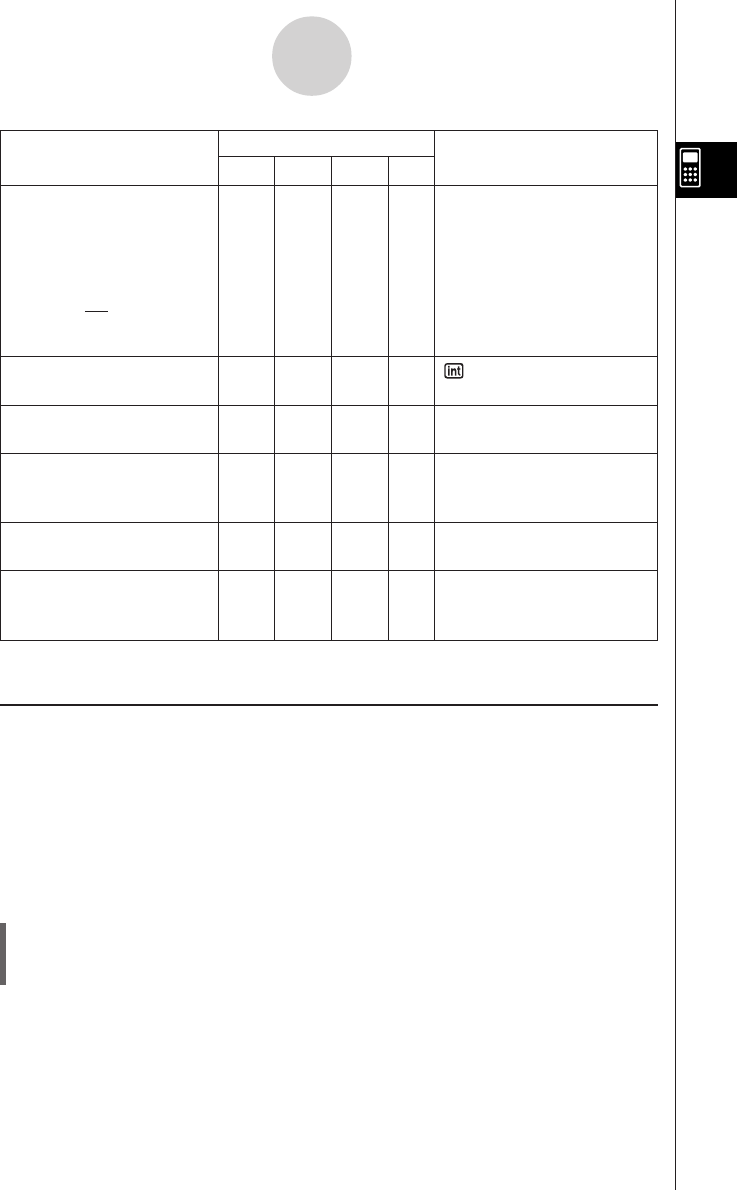User Manual
Table Of Contents
- Getting Ready
- Contents
- About This User’s Guide
- Chapter 1 Getting Acquainted
- Chapter 2 Using the Main Application
- 2-1 Main Application Overview
- 2-2 Basic Calculations
- 2-3 Using the Calculation History
- 2-4 Function Calculations
- 2-5 List Calculations
- 2-6 Matrix and Vector Calculations
- 2-7 Using the Action Menu
- 2-8 Using the Interactive Menu
- 2-9 Using the Main Application in Combination with Other Applications
- 2-10 Using Verify
- Chapter 3 Using the Graph & Table Application
- Chapter 4 Using the Conics Application
- Chapter 5 Using the 3D Graph Application
- Chapter 6 Using the Sequence Application
- Chapter 7 Using the Statistics Application
- 7-1 Statistics Application Overview
- 7-2 Using List Editor
- 7-3 Before Trying to Draw a Statistical Graph
- 7-4 Graphing Single-Variable Statistical Data
- 7-5 Graphing Paired-Variable Statistical Data
- 7-6 Using the Statistical Graph Window Toolbar
- 7-7 Performing Statistical Calculations
- 7-8 Test, Confidence Interval, and Distribution Calculations
- 7-9 Tests
- 7-10 Confidence Intervals
- 7-11 Distribution
- 7-12 Statistical System Variables
- Chapter 8 Using the Geometry Application
- Chapter 9 Using the Numeric Solver Application
- Chapter 10 Using the eActivity Application
- Chapter 11 Using the Presentation Application
- Chapter 12 Using the Program Application
- Chapter 13 Using the Spreadsheet Application
- Chapter 14 Using the Setup Menu
- Chapter 15 Configuring System Settings
- 15-1 System Setting Overview
- 15-2 Managing Memory Usage
- 15-3 Using the Reset Dialog Box
- 15-4 Initializing Your ClassPad
- 15-5 Adjusting Display Contrast
- 15-6 Configuring Power Properties
- 15-7 Specifying the Display Language
- 15-8 Specifying the Font Set
- 15-9 Specifying the Alphabetic Keyboard Arrangement
- 15-10 Optimizing “Flash ROM”
- 15-11 Specifying the Ending Screen Image
- 15-12 Adjusting Touch Panel Alignment
- 15-13 Viewing Version Information
- Chapter 16 Performing Data Communication
- Appendix

20050501
Problem
Use this keyboard:
Operation
mth abc cat 2D
What is the sign of Func [signum] - 3.4567 w
–3.4567? –1
(signum returns –1 for a
negative value, 1 for a
positive value, “Undefined”
for 0, and
A
for an
A
imaginary number.)
What is the integer part of CALC Func - 3.4567 w
–3.4567? –3
What is the decimal part of Func [frac] - 3.4567 w
–3.4567? –0.4567
What is the greatest integer Func [intg] - 3.4567 w
less than or equal to
–3.4567? –4
What is –3.4567 rounded to Func [fRound] - 3.4567 , 2
two decimal places? –3.46 w
What is –34567 rounded to Func [sRound] - 34567 , 4
four significant digits? w*
–34570
*To round to 10 digits, specify “0” for the second argument.
k Random Number Generator (rand, randList, RandSeed)
• The ClassPad random number generator can generate truly random numbers (non-
sequential random numbers) and random numbers that follow a particular pattern (sequen-
tial random numbers). Using the “randList” function, you can generate a list whose
elements contain random numbers. There are nine different patterns for generation of
sequential random numbers. Use the “RandSeed” command to switch between non-
sequential and sequential random number generation, and to select the sequential random
number generation pattern.
u ClassPad Operation
(1) Use the “RandSeed” command to configure random number generation settings, if
required.
(2) Use the “rand” function or “randList” function to generate the random numbers.
2-4-6
Function Calculations










